Taonius belone
Richard E. YoungIntroduction
Taonius belone is the tropical Indo-Pacific congener of the temperate/boreal Pacific T. borealis. Nesis (1972) originally described two subspecies under the name T. borealis : T. b. borealis and T. b. pacifica. The latter was based largely on Sasaki's 1929 description of "T. pavo" much of which is reproduced below. However, Chun (1906, 1910) had described a juvenile species of the genus (T. belone) from the Indian Ocean and Nesis (1982/87) placed T. b. pacifica within the synonymy of T. belone. N. Voss (see Nomenclature under the Taonius genus page) is very familiar with this genus and supports this synonomy.
Brief diagnosis:
A Taonius with ...
- Largest club sucker with two primary hook-like tooth and no secondary hook-like teeth.
- Large club suckers of marginal series of manus laterally compressed.
Characteristics
- Arms
- Arms short; formula: 3>2=4>1.
- Protective membranes narrow except their proximal part, which are wide and connected together into an internal umbrella.
- Arm suckers biserial throughout, crowded distally; suckers number 21 pairs or more on each arm. Largest suckers about 8th pair.
- Larger suckers with 20-30, broad, closely set teeth around entire margin of ring; distal suckers with only 6-8 teeth; proximal suckers with teeth united appearing smooth except for few distal undulations.
 Click on an image to view larger version & data in a new window
Click on an image to view larger version & data in a new window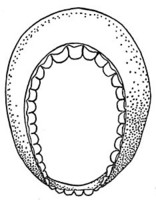
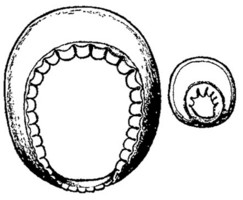
Figure. Oral views of arm suckers of T. belone. Left - Arm III, sucker 20, 119 mm ML. Drawing from Voss (1963). Middle - Large arm sucker, 330 mm ML. Right - Distal arm sucker, 330 mm ML. Latter two drawings from Sasaki (1929).
- Arms short; formula: 3>2=4>1.
- Tentacles
- Largest two (?) suckers of medial two series of club manus with one or two enlarged, hook-like teeth; smaller secondary teeth absent.
- Other enlarged suckers of medial series of club manus with two largest hook-like teeth more nearly equal in size; 4-5 smaller secondary teeth present.
- Suckers of marginal series of manus laterally compressed, each with two elongate, incurved teeth on distal and pointed teeth on lateral margin of sucker ring.
- Tentacular stalk with two series of locking suckers on distal 2/3 to 3/4 of stalk. Indistinct carpal cluster at base of manus.
 Click on an image to view larger version & data in a new window
Click on an image to view larger version & data in a new window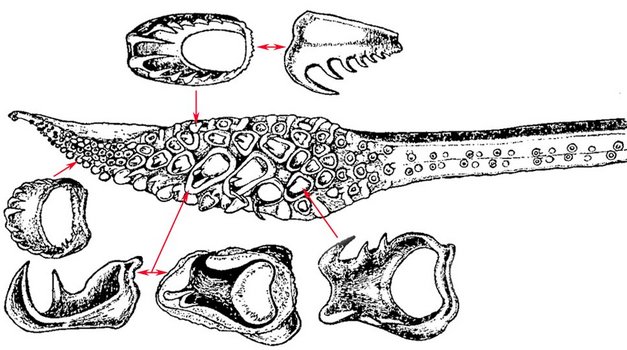
Figure. Oral view of the tentacular club of T. belone, 330 mm ML, showing enlargement of some suckers. Drawing from Sasaki (1929).
 Click on an image to view larger version & data in a new window
Click on an image to view larger version & data in a new window
Figure. Oral views of club sucker rings of T. belone, Phillipine Islands. Drawing from Voss (1963).
- Head
- Beaks: Descriptions can be found here: Lower beak; upper beak.
- Beaks: Descriptions can be found here: Lower beak; upper beak.
- Mantle
- At funnel-mantle fusion, tubercules absent .
- Mantle skin smooth.
- Fins
- Fins elongate, lanceolate and subterminal; each fin at anterior insertion broadly separated from each other; fin length 44% of ML.
- Gladius extends beyond fins as axis of tail .
Comments
The above characteristics are taken from Sasaki, 1929 and Voss, 1963.
Life History
Paralarvae of T. belone from Hawaiian waters have been identified. they are distinctive among cranchiid paralarvae from these waters in the near lack of chromatophores.


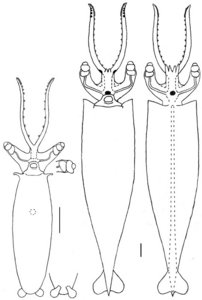
Figure. Paralarvae of T. belone, Hawaiian waters. Thumbnail (far left) - Illustration shows relative sizes of the two paralarvae. Left - Ventral view of a 4.9 mm ML paralarva. The dotted circle in indicates the position of the digestive gland. The adjacent inserts show (1) a side view of an eye and (2) a dorsal view of the fins. This paralarva has no chromatophores. Right - Ventral and dorsal views of a 14.5 mm ML paralarva. This paralarva has one chromatophore on the dorsal and one on the ventral surface of the head and a few chromatophores on the aboral surface of each tentacular club and one at the base of each tentacle but none on the mantle. Also note the small size of the tentacular club and the shape of the fins. The scale bars are 1 mm. Drawings by R. Young.

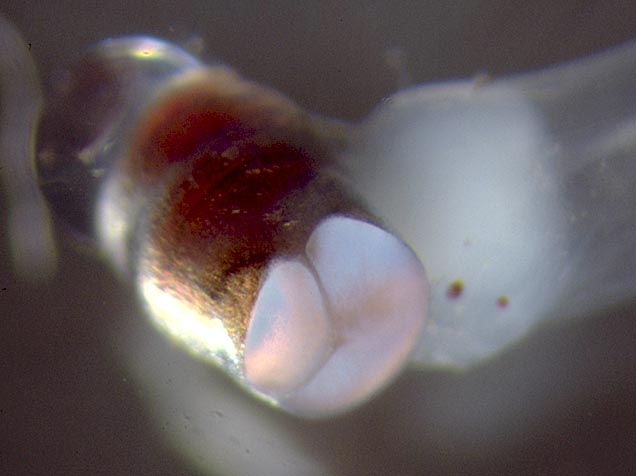

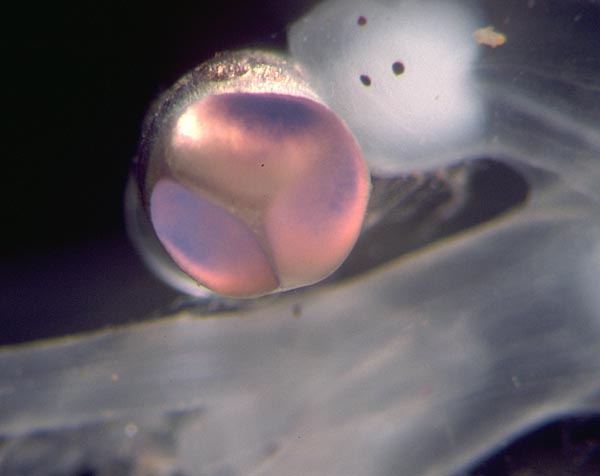
Figure. Ventral-oblique (left) and ventral (right) views of a tubular eye of a juvenile T. belone, off Hawaii. Photograph by R. Young.
The laterally compressed eyes of paralarvae will reduce the size of a shadow cast by the opaque eyeballs under the highly directional downwelling daylight to aid in camouflage. In deeper waters where the intensity of downwelling daylight is reduced the upward looking tubular eye is more easily camouflaged with silvery mirrors on the sides and a photophore on the underside of the eye to match the weak downwelling light and, thereby, eliminate the eye shadow (= counterillumination). In deeper water yet, darkness allows the eye to assume a more normal shape that allows a broader visual field (Young, 1975).Distribution
Geographical distribution
Type locality: Indian Ocean at 10°8'S, 97°14'E.
Found off southern Japan, Philippine Islands, Hawaiiiian Islands, central equatorial Pacific and, presumably throughout the tropical and subtropical Indo-Pacific, but details are poorly known.
Vertical distribution
Off Hawaii T. belone appears to exhibit ontogenetic descent and not to undergo diel vertical migration (Young, 1975).

Figure. Vertical distribution of T. belone, Hawaiian waters. Captures were made with both open and opening/closing trawls. Bars - fishing depth-range of opening/closing trawl. Circle - Modal fishing depth for either trawl. Blue-filled circles - Night captures. Yellow-filled circles - Day capture. Chart modified from Young (1975).
References
Sasaki, M. 1929. A Monograph of the Dibranchiate Cephalopods of the Japanese and Adjacent Waters. Journal of the College of Agriculture, Hokkaido Imperial University, 20(supplement):357 pages.
Voss, G. L. 1963. Cephalopoda of the Philippine Islands. Bull. U. S. Nat. Mus., 234: 1-180.
Title Illustrations

| Scientific Name | Taonius belone |
|---|---|
| Location | Near Koshiki Island, Kiushiu, Japan |
| Reference | Sasaki, M. 1929. A Monograph of the Dibranchiate Cephalopods of the Japanese and Adjacent Waters. Journal of the College of Agriculture, Hokkaido Imperial University, 20(supplement):357 pages. |
| View | Ventral |
| Size | 330 mm |
| Collection | USNM 332946 |
| Type | Holotype |
About This Page

University of Hawaii, Honolulu, HI, USA
Correspondence regarding this page should be directed to Richard E. Young at
Page copyright © 2019
 Page: Tree of Life
Taonius belone .
Authored by
Richard E. Young.
The TEXT of this page is licensed under the
Creative Commons Attribution-NonCommercial License - Version 3.0. Note that images and other media
featured on this page are each governed by their own license, and they may or may not be available
for reuse. Click on an image or a media link to access the media data window, which provides the
relevant licensing information. For the general terms and conditions of ToL material reuse and
redistribution, please see the Tree of Life Copyright
Policies.
Page: Tree of Life
Taonius belone .
Authored by
Richard E. Young.
The TEXT of this page is licensed under the
Creative Commons Attribution-NonCommercial License - Version 3.0. Note that images and other media
featured on this page are each governed by their own license, and they may or may not be available
for reuse. Click on an image or a media link to access the media data window, which provides the
relevant licensing information. For the general terms and conditions of ToL material reuse and
redistribution, please see the Tree of Life Copyright
Policies.
- First online 08 March 2011
- Content changed 26 March 2019
Citing this page:
Young, Richard E. 2019. Taonius belone . Version 26 March 2019 (under construction). http://tolweb.org/Taonius_belone/120159/2019.03.26 in The Tree of Life Web Project, http://tolweb.org/





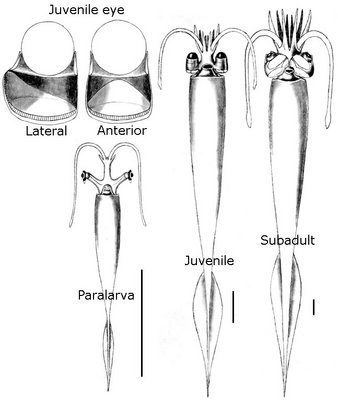



 Go to quick links
Go to quick search
Go to navigation for this section of the ToL site
Go to detailed links for the ToL site
Go to quick links
Go to quick search
Go to navigation for this section of the ToL site
Go to detailed links for the ToL site